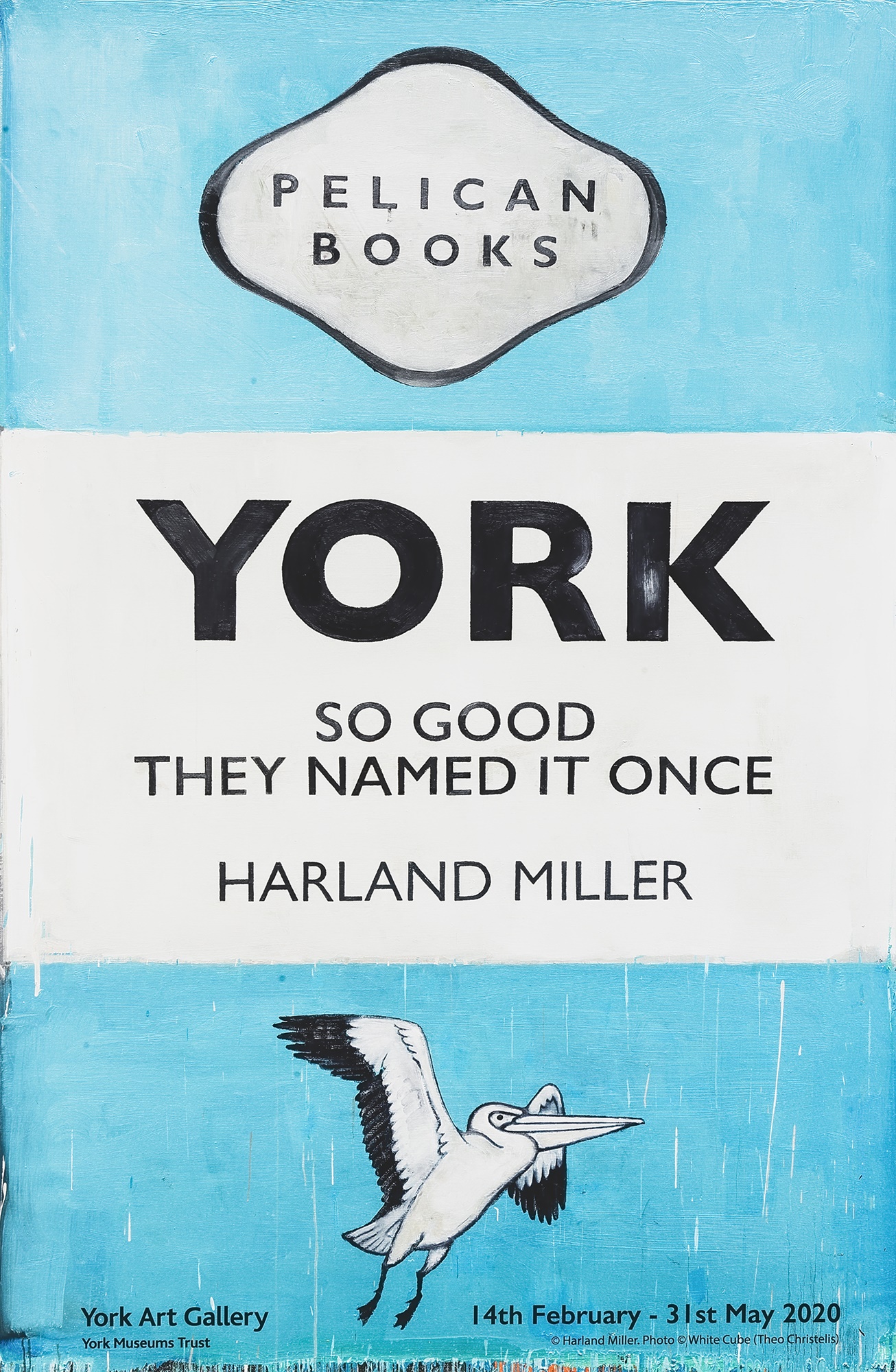Harland Miller is a Yorkshire-born (1964) English writer and artist whose career seamlessly marries literature and visual art in a bold exploration of narrative, humor, and cultural memory. Educated at the Chelsea School of Art (MA 1988), Miller first captivated critics and readers with his debut novel, Slow Down Arthur, Stick to Thirty (2000), and followed it with the novella At First I Was Afraid, I Was Petrified, showcasing his dark wit and introspective voice. But it is his later visual works—especially his iconic fictional Penguin and Pelican “book cover” paintings—that solidified his place as a singular figure in contemporary art.

From Words to Canvas: Early Life & Influences
Miller grew up in 1970s Yorkshire, where heavy industry, blackouts during the miners' strike, and the menace of the Yorkshire Ripper shaped a gritty, communal environment Reflecting on that era he said:
“I grew up in Yorkshire in the seventies… power cuts… It did bring people together though—as a family that is the only thing I remember us doing together.”
His early career took him across New York, Berlin, New Orleans, Paris, and London—immersing him in Pop Art, Abstract Expressionism, and color field painting. Miller has credited Rothko, Ed Ruscha, and Mark Rothko as key influences in cultivating his visual style.
Fictional Book Covers: The Signature Style
Penguin Dust-Jackets Reinvented
In 2001, Miller launched his now-celebrated series of canvas paintings that mimic classic Penguin book covers—complete with vintage layouts, weathered textures, and invented titles under the guise of Miller as "author." One early standout was I’m So F**king Hard – Ernest Hemingway, blending literary homage with irreverent wit.
Through this format, Miller intertwines high and low culture:
“I’ve always loved both high and low culture… I think I can say this painting perfectly encapsulates both”.
His titles—Death, What’s In It For Me?, Incurable Romantic Seeks Dirty Filthy Whore, Dirty Northern Bastard—are satirical but emotionally vivid, probing human vulnerability and societal absurdities.

As Miller insightfully noted:
“People read before they can stop themselves… Words offer a way into what you’re looking at… there is this imbalance in terms of how much the words are doing as words.”
Pelican Series & Beyond
Alongside Penguin-inspired paintings, Miller has turned to Pelican covers (non-fiction classics) to unveil unintended poetry in academic format: Happiness: The Case Against, Armageddon: Is it too much to ask?. These works retain his signature style of using humor as a doorway to existential rumination.
Evolving Language: Letter Paintings & Minimalism
In a recent evolution, Miller has stripped his works to single words or acronyms—UP, LUV, YES, even XXX—superimposing letters in saturated geometric canvases and evoking medieval manuscript illumination with a contemporary twist.
His reduction in word count stems from feedback:
“…he gained a reputation for witty remakes… yet… recent times reduced the word‑count… ‘This is great… it saves me the trouble of explaining it.’”
Beyond their visual appeal, the letter paintings explore abstraction, layering, and the interplay of word and form on a primal level—whether through medieval, Deco, or Pop syntax .
Materials, Medium & Exhibitions
While known for large canvases, Miller also works in relief etching, screen prints, sculptural book-objects, and even deckchairs inspired by his book-art motifs. He has held prominent exhibitions:
-
"York, So Good They Named It Once" (York Art Gallery, 2020): A mid‑career retrospective focused on Yorkshire ties.
-
Regular solo shows at White Cube (London, Paris, Hong Kong), including Imminent End, Rescheduled Eternally (2022–23), and thematic group exhibitions rooted in Edgar Allan Poe (ICA 2002, 2008.

Social Impact & Public Engagement
In April 2020, Miller created Who Cares Wins (NHS), a limited edition print that raised over £1.25 million for COVID‑19 charities. The work expressed a profound collective gratitude:
“Caring is all we can do… and caring for the Carers is… one of the ways we can do this best!”.
Narrative Density & Emotional Depth
Miller’s work is rich with “tragi-comedy,” engaging humor to provoke existential contemplation. He creates visual entry points—readers are drawn in, then challenged. His cartoons on death, love, identity, and regret strike a chord:
“When I introduced text into my work… people wrote to me… some… very personal. One asked… use some of my text on their gravestone… liked my irreverent attitude to death.”.
High-Low Cultural Tension
By reappropriating mass-media visuals—dust jackets, T-shirt designs—Miller challenges distinctions between pop culture and fine art. His influences, from Pop to Abstract Expressionism, reflect a lifelong intertwining of cultural refuge and formal experimentation .
Linguistic and Visual Play
Miller’s ongoing mission is to probe the interplay of word, image, color, and form. Whether flamboyant textual comedy or minimalist letter paintings, his work explores how linguistic nuance shapes perception and memory .
The Road Ahead
Harland Miller continues to expand his narrative practice—exploring existential themes such as love, anxiety, mortality, and hope. His recent exhibitions delve into abstraction, immersive letter paintings, and neon echoing color intensities—each layered with linguistic complexity.
As he explained:
“Imminent End, Rescheduled Eternally… unearthed themes of anxiety, love and mortality… gestures of 1950s abstraction…”
In future series—such as “Hell Paintings” (“Hell…Don’t Make Me Come Down There”)—Miller continues drawing on existential motifs, intensifying his commitment to humor and emotional revelation through visual text
Harland Miller is a cultural chameleon—writer and painter, humorist and philosopher, popular artist with a provocative edge. From Yorkshire’s shadowed youth to global recognition, his journey reflects an unwavering engagement with language as image, visual form as sentiment. Whether it’s a satirical Penguin cover or a minimal single-word canvas, each painting is a distilled narrative—witty, poetic, and deeply human.

What he achieves through his practice is the fusion of reader and viewer, merging word and pigment to stimulate laughter, introspection, and connection. His art reminds us: a cover may hold a story, but sometimes, you complete it. Discover original Harland Miller prints for sale and contact our galleries via info@guyhepner.com for further information. Looking to sell? We can help. Find out how to sell Harland Miller art with our expert team.











